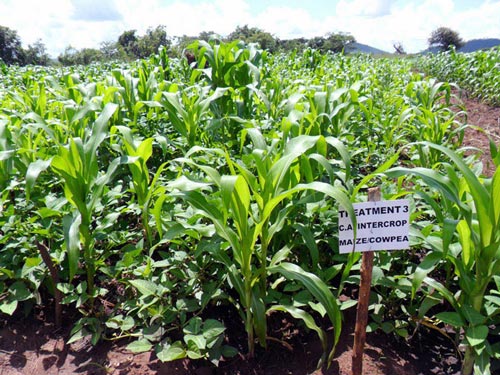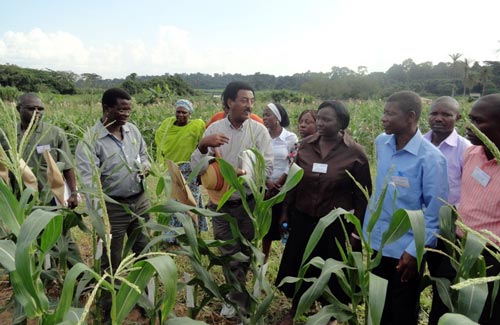 To reduce farm labor, improve soil productivity and crop yields, and contribute towards food security of farming households in the changing climate environment, CIMMYT, the International Institute of Tropical Agriculture (IITA), and the Zambian Agriculture Research Institute (ZARI) introduced and expanded conservation agriculture (CA) in Zambia. The activities are implemented under the Sustainable Intensification of Maize-Legume based Cropping Systems for Food Security in Eastern Province of Zambia (SIMLEZA) project funded by USAID.
To reduce farm labor, improve soil productivity and crop yields, and contribute towards food security of farming households in the changing climate environment, CIMMYT, the International Institute of Tropical Agriculture (IITA), and the Zambian Agriculture Research Institute (ZARI) introduced and expanded conservation agriculture (CA) in Zambia. The activities are implemented under the Sustainable Intensification of Maize-Legume based Cropping Systems for Food Security in Eastern Province of Zambia (SIMLEZA) project funded by USAID.
CA entails reduced or no tillage systems, keeping crop residue on the soil surface as mulch, and using crop rotation. It increases the infiltration of water in the soil and thus reduces soil erosion and surface run-off of water that is desperately needed for plant production. This is a crucial change in regions like Zambia’s Eastern Province, where most smallholder farmers engage in the traditional ridge and furrow farming and planting maize in monocropping. While ridging was once promoted as a measure against erosion and high intensity rainfall, it now shows its drawbacks: ridge preparation, mostly done by women and children, is long, tedious, and difficult as most farmers use hoes. Furthermore, farm productivity in Eastern Zambia is already generally low due to increasingly erratic rainfall, low fertilizer use, soil degradation, pests and diseases in the monocropped maize, and weeds, which leads to yields too low to sustain households’ food requirements from one harvest to the next. Crop rotation and diversification help farmers arrest the spread of disease and reduce the risk of crop failure. In addition, they enable farmers to grow cereals and legumes, a source of cash and food crops to boost household incomes.
To address these issues, CIMMYT organized community meetings to raise awareness on CA and conducted training sessions for extension officers and farmers to build knowledge, capacity, and skills. Facilitators from CIMMYT and IITA led a hands-on training for extension officers in November 2011. The extension officers then went on to train farmers in their communities and facilitated the establishment of demonstration plots, where they showcased successful examples of CA systems. The demonstration plots serve as learning centers for farmers in each community. Farmers also have a chance to share information on CA through farmer-to-farmer exchange visits, field days, and community meetings.
Maren Tembo, who hosts a demonstration plot in the Mangena community in Chipata District, is excited about this new technology: “The practice demands less labor, which enables me to grow other crops such as groundnuts, tobacco, and cotton. I’m looking forward to earning additional income from these crops to supplement my current household budget.” Another farmer from the district, Mulenga Zulu, has also benefitted from the project. “My crop shows greater yields than before. I anticipate higher profits as a result of applying CA on my farm,” he says. Like Tembo, he is also happy about the reduced labor demands.
 Having experienced CA, both Tembo and Zulu hope that more farmers will adopt the practice. “This project should continue so that others can learn from us that we do things differently now,” she added. Learning about CA has enabled Tembo to lessen the challenges her family faces, especially the tedious labor in preparing the field. Zulu is proud to see that other farmers admire what they see on his farm.
Having experienced CA, both Tembo and Zulu hope that more farmers will adopt the practice. “This project should continue so that others can learn from us that we do things differently now,” she added. Learning about CA has enabled Tembo to lessen the challenges her family faces, especially the tedious labor in preparing the field. Zulu is proud to see that other farmers admire what they see on his farm.
The future of the project is promising: with testimonies from fellow farmers, assistance from dedicated extension workers, and community media broadcasts, more farmers in the neighboring districts are bound to pick up the practice. Besides higher yields for less work, there is an added long-term bonus for the farmers: their interaction with service providers, initiated through the project, will improve their market access for both farm inputs and outputs.
 Capacity development
Capacity development 
